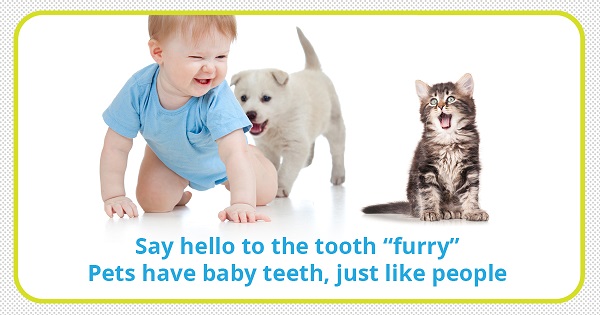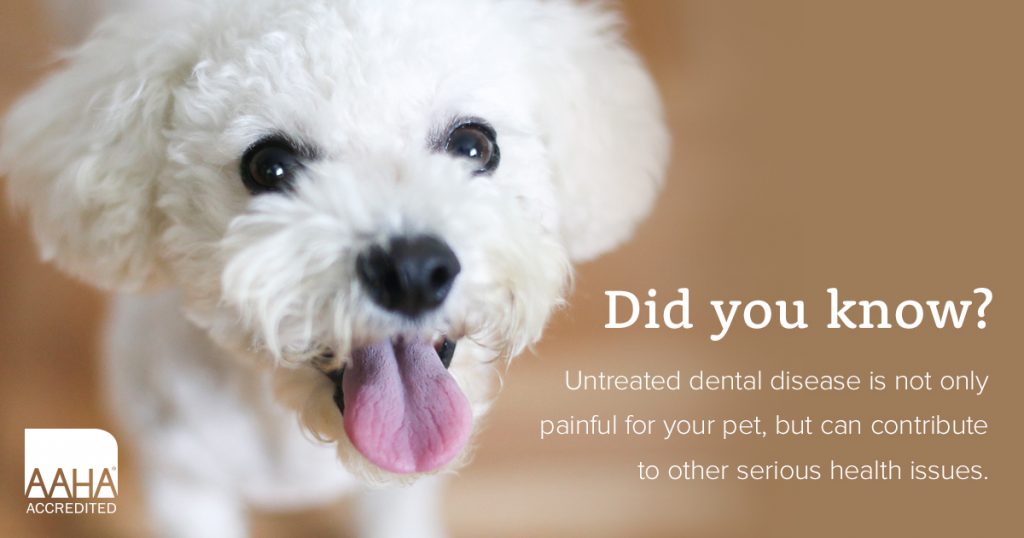
Just like human babies, puppies and kittens go through a teething stage. During this stage the “baby teeth” will become loose and fall out when the adult teeth grow in . Your pet could experience discomfort during the teething stage and may chew just about anything they can get their paws on. Providing safe chew toys will help alleviate your pet’s discomfort and save your furniture from a pet’s teeth marks. These baby teeth often get swallowed or lost, but if you’re lucky you might find one as your puppy or kitten grows up. If the teeth don’t fall out, though, your veterinarian might need to help take them out. So if your pet is more than 5 months old and their teeth look a bit strange, have a veterinarian take a look. We can remove these retained baby teeth when your pets get spayed or neutered.
Once your  pet’s adult teeth have grown in, over time they will accumulate a build-up of tartar and plaque, which can cause your pet’s teeth to deteriorate or their gums to become infected. Plaque and tartar build-up increases the likeliness that a pet will develop gingivitis (inflammation of the gum tissue), which can lead to periodontal disease – a damaging stage of infection that affects the entire body. It’s important to implement a preventative dental care plan for your pet in order to keep their mouth healthy. A proper diet and regular chewing exercises can help ensure your pet’s mouth stays healthy. You can also help your pet become accustomed to having their teeth brushed, as this can help prevent the build-up of plaque and tartar.
pet’s adult teeth have grown in, over time they will accumulate a build-up of tartar and plaque, which can cause your pet’s teeth to deteriorate or their gums to become infected. Plaque and tartar build-up increases the likeliness that a pet will develop gingivitis (inflammation of the gum tissue), which can lead to periodontal disease – a damaging stage of infection that affects the entire body. It’s important to implement a preventative dental care plan for your pet in order to keep their mouth healthy. A proper diet and regular chewing exercises can help ensure your pet’s mouth stays healthy. You can also help your pet become accustomed to having their teeth brushed, as this can help prevent the build-up of plaque and tartar.
“One of the best things a pet owner can do is brush their pet’s teeth daily,” says Dr. Doug Roberts, a veterinarian at Cornwallis Veterinarians in Kentville, N.S. and Past-President of the Canadian Veterinary Medical Association. “Brushing of the teeth is best introduced when the pet is young and with lots of positive reinforcement.” Starting early is ideal. Within a few days of bringing your new puppy or kitten home, get them used to having their mouth and muzzle area touched. The pet should not be permitted to bite your fingers or hands. Keep the contact brief. Good behaviour can be rewarded with a small treat, praise, a scratch behind the ears, or a belly rub. As your pet becomes comfortable with its mouth being handled, brushing with a pet toothbrush can be introduced. Human toothpastes should not be used on pets, as they may upset your pet’s stomach. Special toothpastes are available for pets in flavours that will appeal to them. If you need guidance on brushing your pet’s teeth, a member of your veterinary health care team can help you.
As your puppy or kitten grows, each year at their annual veterinary visit the doctor will conduct an oral exam. Talk to your veterinarian about any changes you have noticed in your pet’s mouth. A healthy dog or cat mouth should be odour-free and contain healthy, white, even teeth with coral pink, glistening gums that are tightly adhered to the teeth at the gums.
“During annual veterinary exams, the pet’s teeth are examined and recommendations will be made regarding its dental health and needs,” explains Dr. Roberts. “Many pets will periodically require professional scaling and examination of their teeth by their veterinarian under general anaesthesia.”
Prevention is key when it comes to reducing the incidence of dental disease. Understanding the importance of good oral health, combined with regular visits to the veterinarian and a preventative dental care plan will help ensure a pet stays strong and healthy.
– Canadian Veterinary Medical Association
